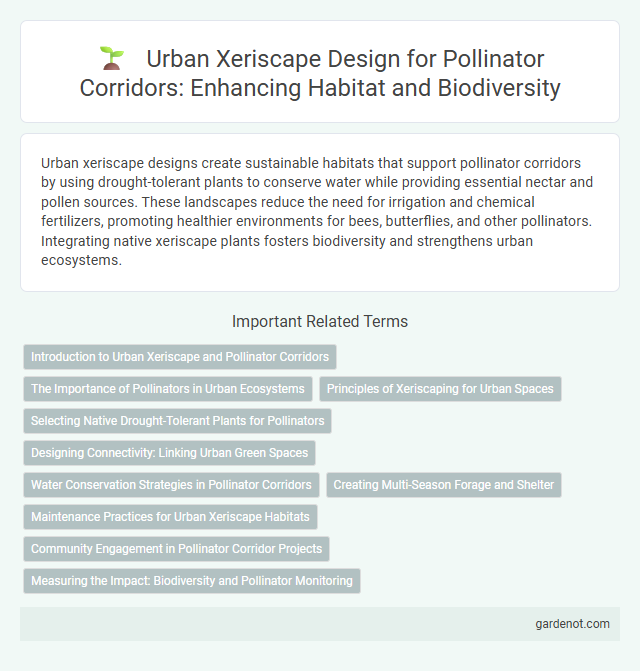Urban xeriscape designs create sustainable habitats that support pollinator corridors by using drought-tolerant plants to conserve water while providing essential nectar and pollen sources. These landscapes reduce the need for irrigation and chemical fertilizers, promoting healthier environments for bees, butterflies, and other pollinators. Integrating native xeriscape plants fosters biodiversity and strengthens urban ecosystems.
Introduction to Urban Xeriscape and Pollinator Corridors
Urban xeriscape integrates drought-tolerant plants into city landscapes, reducing water usage while supporting biodiversity. Pollinator corridors within xeriscaped areas create continuous habitats that facilitate the movement and health of essential pollinators like bees, butterflies, and hummingbirds. This synergy enhances urban ecosystem resilience, promotes native flora, and improves overall environmental sustainability.
The Importance of Pollinators in Urban Ecosystems
Urban xeriscape gardens play a crucial role in supporting pollinator populations by providing drought-resistant plants that offer essential nectar and pollen throughout the year. Pollinators such as bees, butterflies, and hummingbirds contribute significantly to urban biodiversity and enhance the reproduction of native flora, which improves air quality and mitigates heat island effects. Integrating pollinator-friendly xeriscapes into urban planning promotes ecological resilience and strengthens food security within city environments.
Principles of Xeriscaping for Urban Spaces
Urban xeriscape designs emphasize water-efficient landscaping by selecting native, drought-tolerant plants that support pollinator corridors. Principles of xeriscaping for urban spaces include soil amendment for improved permeability, efficient irrigation techniques such as drip systems, and strategic plant grouping to minimize water usage. These methods create sustainable habitats that enhance biodiversity while conserving urban water resources.
Selecting Native Drought-Tolerant Plants for Pollinators
Selecting native drought-tolerant plants such as purple coneflower (Echinacea purpurea), blanket flower (Gaillardia), and milkweed (Asclepias spp.) enhances urban xeriscape pollinator corridors by providing essential nectar and habitat. These species are adapted to local climate conditions, reducing water usage while supporting critical pollinator populations like bees, butterflies, and hummingbirds. Incorporating a diverse mix of native perennials in urban landscapes ensures continuous flowering throughout the growing season, maximizing pollinator attraction and biodiversity.
Designing Connectivity: Linking Urban Green Spaces
Urban xeriscape designs enhance pollinator corridors by strategically linking fragmented green spaces through drought-tolerant plantings that provide continuous nectar and habitat resources. Implementing native, water-efficient flora such as lavender, salvia, and milkweed creates sustainable pathways that support bee, butterfly, and other pollinator movement across urban landscapes. Incorporating these corridor connections reduces habitat isolation, promotes biodiversity, and contributes to resilient urban ecosystems amid increasing water scarcity.
Water Conservation Strategies in Pollinator Corridors
Urban xeriscape designs in pollinator corridors prioritize drought-resistant native plants to minimize water usage. Mulching and efficient drip irrigation systems enhance water retention and reduce evaporation, supporting pollinator habitats during dry periods. Integrating these water conservation strategies fosters sustainable urban biodiversity while conserving valuable water resources.
Creating Multi-Season Forage and Shelter
Urban xeriscape designs enhance pollinator corridors by incorporating drought-tolerant native plants that provide continuous forage and shelter across multiple seasons. Strategic planting of diverse flowering species such as lavender, salvia, and yarrow ensures nectar availability from early spring through late fall, supporting bees, butterflies, and other pollinators. Structural elements like rock piles and dense shrub clusters offer critical nesting and overwintering habitats, promoting year-round pollinator survival in arid city landscapes.
Maintenance Practices for Urban Xeriscape Habitats
Urban xeriscape habitats benefit from low-water maintenance practices such as drip irrigation, mulching, and selective pruning to conserve moisture and promote plant health. Regular monitoring for invasive species and replacing non-native plants with drought-resistant natives enhances pollinator corridors by supporting essential nectar sources. Implementing seasonal maintenance schedules reduces resource input while maintaining structural habitat complexity vital for pollinator nesting and foraging.
Community Engagement in Pollinator Corridor Projects
Urban xeriscape techniques reduce water usage and create sustainable habitats essential for pollinators within city environments. Community engagement in pollinator corridor projects fosters local stewardship, promoting native plantings that support bees, butterflies, and other vital pollinators. Collaborative efforts between residents, schools, and municipalities enhance biodiversity and resilience in urban ecosystems.
Measuring the Impact: Biodiversity and Pollinator Monitoring
Urban xeriscape gardens significantly enhance pollinator corridors by providing drought-tolerant native plants that support diverse pollinator species. Measuring the impact involves systematic biodiversity assessments and pollinator monitoring using standardized protocols such as transect counts and pollinator visitation rates. Data collected helps quantify increases in pollinator abundance and species richness, validating xeriscaping as an effective strategy for urban biodiversity conservation.
Urban xeriscape Infographic

 gardenot.com
gardenot.com